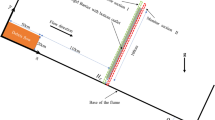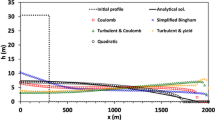Abstract
The scour and flow field patterns with accumulation of debris around bridge piers are completely different due to the reduction of flow area and the increase in depth average velocity. Accordingly, the risks of bridge piers failure are increased due to the evolution of scour depth. This paper aims to analyse the effect of rectangular debris accumulation around single and dual cylindrical piers on river bed morphology in three dimensional simulation under clear water conditions. An experimental and numerical investigations were conducted to implement computational fluid dynamic (CFD) models that reveal the influence debris accumulation on the characteristics of scour hole and the increase in depth average velocity. The large eddy simulation model (LES) was coupled with three morphological models (Meyer-Peter, and Muller; Van Rijn model, and Nielsen) to assess the performance of simulation and produce efficient CFD morphological models. It was found that coupling of LES turbulence model and Nielsen morphological model yield best agreement with measured scour depth and scour hole characteristics according to the indication of statistical analysis, while the under prediction was noted for other models. As compared with temporal scour development and scour hole morphology of experiments of this study, good agreement was achieved for implemented CFD morphological models for single pier and dual piers with debris accumulation for (6.2 and 16.6% obstructed area to the flow area) respectively. According to the indications of this study, the increase in depth average velocity due to debris accumulation can be ranged from 26 to 44% and from 17 to 41% during the first ten minutes of accumulation around single and dual piers respectively. More consideration should be taken to mitigate bridge piers from debris accumulation.














Similar content being viewed by others
REFERENCES
Al-Awadi, A.T. and Al-Khafaji, M.S., Scour depth at single cylindrical bridge piers with debris jam: an experimental comparative study, IOP Conf. Ser. Materials Sci. Engineering, 2020, vol. 671, no. 1, p. 012101
Al-Khafaji, M.S., Ali, S.A., and Rusul, I.A., Effect of floating debris on local scour at bridge piers, Eng. Tech. J., 2016, vol. 34, pp. 356–367.
Amini, A. and Solaimani, N., The effects of uniform and no uniform pile spacing variations on local scour at pile groups, Marine Georesour. Geotechnol., 2018, vol. 36, no. 7, pp. 861–866.
Ebrahimi, M.O.H.S.E.N., Kahraman, R.E.C.E.P., Kripakaran, P.R.A.K.A.S.H., Djordjevic, S., Tabor, G., Prodanović, D.M., Arthur, S., and Riella, M., Scour and hydrodynamic effects of debris blockage at masonry bridges: Insights from experimental and numerical modelling, E-proc. 37th IAHR World Congress, 2017, Kuala Lumpur, Malaysia.
Flow Science, FLOW-3D Version 11.2.0 User Manual, Santa Fe, M.: Flow Science, Inc., 2016. https://www.flow3d.com
Lagasse, P.F., Clopper, P.E., and Zevenbergen, L.W., Effects of “Debris on Bridge Pier Scour, NCHRP” Report 653, Transportation Research Board, Washington: National Acad. Sci., D.C., 2010.
Lança, R.M., Simarro, G., Fael, C.M., and Cardoso, A.H., Effect of viscosity on the equilibrium scour depth at single cylindrical piers, J. Hydraul. Eng., 2015, vol. 142, no. 3, p.06015022.
Melville, B.W., Pier and abutment scour: Integrated approach, J. Hydraul. Eng., 1997, vol. 123, no. 2, pp. 125–136.
Melville, B.W. and Dongol, D.M., Bridge pier scour with debris accumulation, J. Hydraul.. Eng., 1992, vol. 118, no. 9, pp. 1306–1310.
Meyer-Peter, E. and Muller, R., Formulas for bed-load transport, Proc. 2nd Meeting Int. Association for Hydraulic Structures Research, Int. Association of Hydraulic Res., Delft, 1948.
Nakayama, Y. and Boucher, R.F., Introduction to Fluid Mechanics, YOKENDO CO. LTD, Japan, 1999.
Nielsen, P., Coastal bottom boundary layers and sediment transport, World Sci., 1992, vol. 4.
Pagliara, S. and Carnacina, I., Influence of wood debris accumulation on bridge pier scour, J. Hydraul. Eng., 2010, vol. 137, no. 2, pp. 254–261.
Pagliara, S. and Carnacina, I., Influence of large woody debris on sediment scour at bridge piers, Int. J. Sedim. Res., 2011, vol. 26, no. 2, pp.121–136.
Pagliara, S. and Carnacina, I., Bridge pier flow field in the presence of debris accumulation, Proc. Institution of Civil Engineers-Water Management, 2013, vol. 166, no. 4, pp. 187–198.
Panici, D. and De Almeida, G.A., Understanding the formation of woody debris accumulations at bridge piers, E-proceedings of the 37th IAHR World Congress, 2017, Kuala Lumpur, Malaysia IAHR.
Park, J.H., Sok, C., Park, C.K., and Do Kim, Y., A study on the effects of debris accumulation at sacrificial piles on bridge pier scour: I. Experimental results, KSCE J. Civil Eng., 2016, vol. 20, no. 4, pp. 1546–1551.
Rahimi, E., Qaderi, K., Rahimpour, M., and Ahmadi, M.M., Effect of Debris on Piers Group Scour: An Experimental Study, KSCE J. Civil Eng., 2018, vol. 22, no. 4, pp. 1496–1505.
Raudkivi, A.J., Functional trends of scour at bridge piers, J. Hydraulic. Eng., 1986, vol. 112, no. 1, pp. 1–13.
Raudkivi, A.J. and Ettema, R., Clear-water scour at cylindrical piers, J. Hydraulic. Eng., 1983, vol. 109, no. 3, pp. 338–350.
Soulsby, R. L. and Whitehouse, R.J.S.W., Threshold of sediment motion in Coastal Environments, Proc. Combined Australian Coastal Engineering and Port Conf., EA, 1997, pp. 149–154.
Tafarojnoruz, A., Gaudio, R., Grimaldi, C., Calomino, F., Required conditions to achieve maximum local scour depth at a circular pier, Proc. XXXII Convegno Nazionale di Idraulica e Costruzioni Idrauliche, 2010, Palermo, Italy.
Tropsha, A., Gramatica, P., and Gombar, V.K., The importance of being earnest: validation is the absolute essential for successful application and interpretation of QSPR models, QSAR & Combinatorial Sci., 2003, vol. 22, no. 1, pp. 69–77.
Van Rijn, L.C., Sediment Transport, Part I: Bed load transport, J. Hydraul. Eng., 1984, vol. 110, no. 10, pp. 1431–1456.
Wei, G., Brethour, J., Grünzner, M., and Burnham, J., The sedimentation scour model in FLOW-3D®, Flow Sci. Rep., 2014, pp. 03–14.
Author information
Authors and Affiliations
Corresponding authors
Rights and permissions
About this article
Cite this article
Al-Awadi, A., Al-Khafaji, M. CFD-Based Model for Estimating the River Bed Morphological Characteristics near Cylindrical Bridge Piers Due to Debris Accumulation. Water Resour 48, 763–773 (2021). https://doi.org/10.1134/S0097807821050031
Received:
Revised:
Accepted:
Published:
Issue Date:
DOI: https://doi.org/10.1134/S0097807821050031




